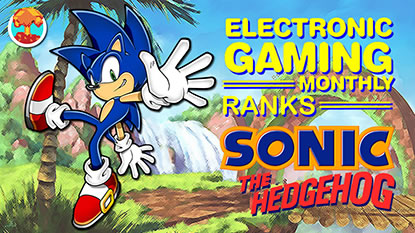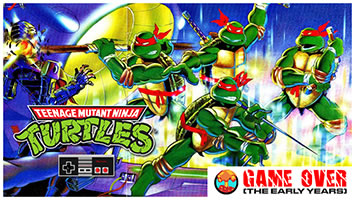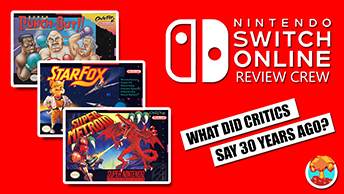- CLASSIC MAGAZINES
- REVIEW CREW
A show recapping what critics thought back
when classic games first came out! - NEXT GENERATION'S BEST & WORST
From the worst 1-star reviews to the best
5-stars can offer, this is Next Generation! - NINTENDO POWER (ARCHIVE)
Experience a variety of shows looking at the
often baffling history of Nintendo Power! - MAGAZINE RETROSPECTIVE
We're looking at the absolutely true history of
some of the most iconic game magazines ever! - SUPER PLAY'S TOP 600
The longest and most ambitious Super NES
countdown on the internet! - THEY SAID WHAT?
Debunking predictions and gossip found
in classic video game magazines! - NEXT GENERATION UNCOVERED
Cyril is back in this spin-off series, featuring the
cover critic review the art of Next Generation! - HARDCORE GAMER MAGAZING (PDF ISSUES)
Download all 36 issues of Hardcore Gamer
Magazine and relive the fun in PDF form!
- REVIEW CREW
- ELECTRONIC GAMING MONTHLY
- ELECTRONIC GAMING MONTHLY RANKS
From Mario to Sonic to Street Fighter, EGM
ranks classic game franchises and consoles! - ELECTRONIC GAMING MONTHLY BEST & WORST
Counting down EGM’s best and worst reviews
going year by year, from 1989 – 2009! - ELECTRONIC GAMING BEST & WORST AWARDS
11-part video series chronicling the ups and
downs of EGM’s Best & Worst Awards!
- ELECTRONIC GAMING MONTHLY RANKS
- GAME HISTORY
- GAME OVER: STORY BREAKDOWNS
Long-running series breaking down game
stories and analyzing their endings! - A BRIEF HISTORY OF GAMING w/ [NAME HERE]
Real history presented in a fun and pithy
format from a variety of game historians! - THE BLACK SHEEP
A series looking back at the black sheep
entries in popular game franchises! - INSTANT EXPERT
Everything you could possibly want to know
about a wide variety of gaming topics! - FREEZE FRAME
When something familiar happens in the games
industry, we're there to take a picture! - I'VE GOT YOUR NUMBER
Learn real video game history through a series
of number-themed episodes, starting at zero! - GREAT MOMENTS IN BAD ACTING
A joyous celebration of some of gaming's
absolute worst voice acting!
- GAME OVER: STORY BREAKDOWNS
- POPULAR SHOWS
- DG NEWS w/ LORNE RISELEY
Newsman Lorne Riseley hosts a regular
series looking at the hottest gaming news! - REVIEW REWIND
Cyril replays a game he reviewed 10+ years
ago to see if he got it right or wrong! - ON-RUNNING FEUDS
Defunct Games' longest-running show, with
editorials, observations and other fun oddities! - DEFUNCT GAMES QUIZ (ARCHIVE)
From online quizzes to game shows, we're
putting your video game knowledge to the test!- QUIZ: ONLINE PASS
Take a weekly quiz to see how well you know
the news and current gaming events! - QUIZ: KNOW THE GAME
One-on-one quiz show where contestants
find out if they actually know classic games! - QUIZ: THE LEADERBOARD
Can you guess the game based on the classic
review? Find out with The Leaderboard!
- QUIZ: ONLINE PASS
- DEFUNCT GAMES VS.
Cyril and the Defunct Games staff isn't afraid
to choose their favorite games and more! - CYRIL READS WORLDS OF POWER
Defunct Games recreates classic game
novelizations through the audio book format!
- DG NEWS w/ LORNE RISELEY
- COMEDY
- GAME EXPECTANCY
How long will your favorite hero live? We crunch
the numbers in this series about dying! - VIDEO GAME ADVICE
Famous game characters answer real personal
advice questions with a humorous slant! - FAKE GAMES: GUERILLA SCRAPBOOK
A long-running series about fake games and
the people who love them (covers included)! - WORST GAME EVER
A contest that attempts to create the worst
video game ever made, complete with covers! - LEVEL 1 STORIES
Literature based on the first stages of some
of your favorite classic video games! - THE COVER CRITIC
One of Defunct Games' earliest shows, Cover
Critic digs up some of the worst box art ever! - COMMERCIAL BREAK
Take a trip through some of the best and
worst video game advertisements of all time! - COMIC BOOK MODS
You've never seen comics like this before.
A curious mix of rewritten video game comics!
- GAME EXPECTANCY
- SERIES ARCHIVE
- NINTENDO SWITCH ONLINE ARCHIVE
A regularly-updated list of every Nintendo
Switch Online release, plus links to review! - PLAYSTATION PLUS CLASSIC ARCHIVE
A comprehensive list of every PlayStation
Plus classic release, including links! - RETRO-BIT PUBLISHING ARCHIVE
A regularly-updated list of every Retro-Bit
game released! - REVIEW MARATHONS w/ ADAM WALLACE
Join critic Adam Wallace as he takes us on a
classic review marathon with different themes!- DEFUNCT GAMES GOLF CLUB
Adam Wallace takes to the links to slice his way
through 72 classic golf game reviews! - 007 IN PIXELS
Adam Wallace takes on the world's greatest spy
as he reviews 15 weeks of James Bond games! - A SALUTE TO VAMPIRES
Adam Wallace is sinking his teeth into a series
covering Castlevania, BloodRayne and more! - CAPCOM'S CURSE
Adam Wallace is celebrating 13 days of Halloween
with a line-up of Capcom's scariest games! - THE FALL OF SUPERMAN
Adam Wallace is a man of steel for playing
some of the absolute worst Superman games! - THE 31 GAMES OF HALLOWEEN
Adam Wallace spends every day of October afraid
as he reviews some of the scariest games ever! - 12 WEEKS OF STAR TREK
Adam Wallace boldly goes where no critic has
gone before in this Star Trek marathon!
- DEFUNCT GAMES GOLF CLUB
- DAYS OF CHRISTMAS (ARCHIVE)
Annual holiday series with themed-episodes
that date all the way back to 2001!- 2015: 30 Ridiculous Retro Rumors
- 2014: 29 Magazines of Christmas
- 2013: 29 Questionable Power-Ups of Christmas
- 2012: 34 Theme Songs of Christmas
- 2011: 32 Game Endings of Christmas
- 2010: 31 Bonus Levels of Christmas
- 2009: 30 Genres of Christmas
- 2008: 29 Controls of Christmas
- 2007: 34 Cliches of Christmas
- 2006: 33 Consoles of Christmas
- 2005: 32 Articles of Christmas
- 2004: 31 Websites of Christmas
- 2003: 29 Issues of Christmas
- 2002: 28 Years of Christmas
- 2001: 33 Days of Christmas
- NINTENDO SWITCH ONLINE ARCHIVE
- REVIEW ARCHIVE
- FULL ARCHIVE
The High Price of Digital Distribution
Grand Theft Auto IV

I don't know why Niko is running from the police, but I can't wait to find out at the end of the month!
But is it a good deal? Unfortunately this act of convenience comes at a price. Starting this month Amazon will be selling around 150 songs for 89 cents, ten cents cheaper than iTunes (and not using any kind of DRM). To compare these prices we've decided to look

Not only is the Grand Theft Auto: Vice City soundtrack one of the greatest game soundtracks of all time, but it also has some truly memorable DJs!
The San Andreas soundtrack featured eight discs and retailed for $59.99. These eight discs contained exactly 129 tracks, which included 92 licensed songs, several station promos, fake commercials and more. If we assume that all 129 tracks are worth money, then you would be paying 47 cents per track. If you're only talking about the music (since it's unknown whether or not we will even be able to buy the fake commercials and DJ chatter) then it's 65 cents, exactly 24 cents less than Grand Theft Auto IV's system.
And it doesn't stop with San Andreas; we can also look at Rockstar Games' first multi-disc soundtrack. The Vice City soundtrack came on seven discs and retailed for $49.99. Like the San Andreas box set, Vice City featured a bunch of fake commercials, funny DJ stuff and 125 tracks. If we do the math we did with San Andreas, that

And because there's no DRM you can play it on your brand new overpriced iPhone!
If you were the kind of guy who wanted to own every single song in the Grand Theft Auto IV soundtrack (assuming it has 150 tracks) it would cost you more than $130. That's twice the price of even the most expensive Grand Theft Auto box set. And not only is it more expensive to buy the MP3 version of each song, but you also aren't getting the potentially cool artwork and extras. That may not be a big deal to some people, but to collectors it really means something.
What's Wrong With this Argument? While it's true that it costs more per song, the truth is that most people aren't going to buy every Grand Theft Auto IV song. They are, in fact, only going to go after the songs they like, so it gets rid of a lot of the filler that clogged up the box sets. It's a shame that the songs are so expensive, but at least they aren't forcing you to get a lot of stuff you don't need. And it could be worse; Rockstar Games could have teamed with the more expensive iTunes, which actually uses DRM. Oh, and even if this is slightly overpriced, I like the synergy between the video game world and the real world.
Halo
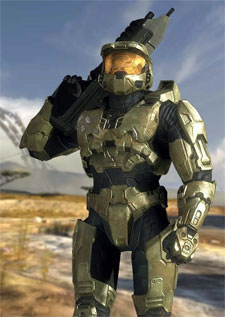
Before Master Chief finished the fight he had another nine multiplayer maps to go through!
And wouldn't you know it? Gamers did. Halo 2 saw one map pack after another, each adding new layers to the product all while padding Bungie's (and Microsoft's) coffers. Eventually Microsoft decided to offer this content to all of the gamers who were too lazy to download them or couldn't afford a yearly
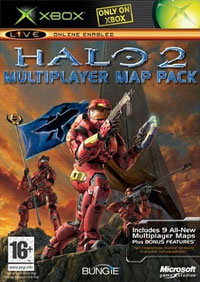
Not shown are the racist, homophobic, anti-Semitic, misogynistic people that spend all day playing Halo 2!
Contrast the $2.22 maps with what we get now with Halo 3, a standard three maps for $9.99 (which averages out to $3.33 per map). Are these new maps that much better than what we saw in Halo 2? Not at all, I would argue that in a lot of ways the new maps are worse than the $2 maps released three years ago. But Bungie doesn't seem concerned about the naysayers, they know that the millions of Halo 3 players will buy what every they give them ... quality or not.
What's Wrong With this Argument? Of course the argument here is that all of the maps in question will be free at some point. At the time of the Halo 2 Multiplayer Map Pack disc, all but four of the maps were free for Xbox Live subscribers. Others would bring up that Halo 3's maps are more versatile, offering you numerous ways of altering its layout and giving you multiple options to change the gameplay. Is that worth a buck extra per map? I don't think so, but then again I'm not the target audience for this kind of thing.
HOME |
CONTACT |
NOW HIRING |
WHAT IS DEFUNCT GAMES? |
NINTENDO SWITCH ONLINE |
RETRO-BIT PUBLISHING
Retro-Bit |
Switch Planet |
The Halcyon Show |
Same Name, Different Game |
Dragnix |
Press the Buttons
Game Zone Online | Hardcore Gamer | The Dreamcast Junkyard | Video Game Blogger
Dr Strife | Games For Lunch | Mondo Cool Cast | Boxed Pixels | Sega CD Universe | Gaming Trend
Game Zone Online | Hardcore Gamer | The Dreamcast Junkyard | Video Game Blogger
Dr Strife | Games For Lunch | Mondo Cool Cast | Boxed Pixels | Sega CD Universe | Gaming Trend
Copyright © 2001-2024 Defunct Games
All rights reserved. All trademarks are properties of their respective owners.
All rights reserved. All trademarks are properties of their respective owners.













